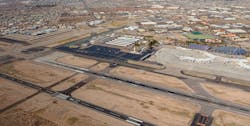HDR Selected to Lead New Runway Design for Tucson International’s Airfield Safety Enhancement Program
The Tucson Airport Authority has chosen HDR to lead the design of its new runway and associated parallel taxiways.
The work is the centerpiece of Tucson International Airport’s $218 million Airfield Safety Enhancement program, the largest project undertaken in the history of the airport.
With a national aviation practice that has worked on some of the biggest airports in the United States, HDR mobilized top aviation engineering experts from across the nation and supplemented that expertise with local knowledge to form a hand-picked design team for the TAA.
Meant to limit runway incursions, the modernization and safety improvements at Tucson International will include the demolition of existing runway 11R/29L, a narrow and short general aviation runway.
The demolished runway will be replaced by Runway 13R/31L, a 10,996 foot long runway, along with a full-length centerline parallel taxiway, new outboard parallel taxiway and new connector taxiways. Among the key considerations is bringing the geometry of the airfield, designed up to 60 years ago, up to the latest Federal Aviation Administration standards.
The new runway will also provide a second parallel runway for commercial and military flights at Tucson International. Currently, routine maintenance or any incidents that shut down the airport’s one full-length runway in the busy summer months can lead to traffic backups as the runway is cleared. Adding a second runway will allow operations to continue without these interruptions.
Design work on the project is expected to begin in October. Construction is scheduled to begin in 2020 and continue through at least 2024.
“The Tucson Airport Authority is embarking on the biggest project in its history, and we’re proud they entrusted HDR with such a critical role,” HDR project manager Scott Sikel said. “Our team is ready to help deliver their vision of becoming one of the safest airports in America.”



